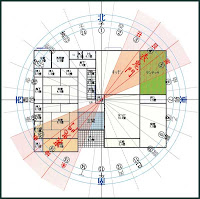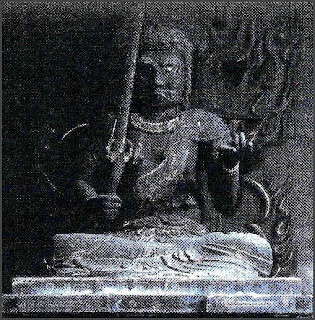[ . BACK to Daruma Museum TOP . ]
. kimon 鬼門の鬼伝説 Oni Demon Gate Legends .
:::::::::::::::::::::::::::::::::::::::::::::::::::::::::::::::::::::::::::::::::::::::::::::::::::::
Kitamuki Fudo ... 北向き不動 ...
Fudo facing North
北向きのお不動さん , 北向不動
kita-muki, kita muki
The north is considered an un-auspicious region and needs protection from real and imagined enemies, fiends and demons.
The deity usually associated with the NORTH is
Bishamonten 毘沙門天
Vaishravana ~ Heavenly King of the North
Tortoise (Black Warrior) = North, Winter, Black, Water
Genbu 玄武
More is here
- - Four Directions (toozai nanboku)- -
East, West, North, South
:::::::::::::::::::::::::::::::::::::::::::::::::::::::::::::::::::::::::::::::::::::::::::::::::::::
Kimon, the "Demon Gate" 鬼門,
quote
Chinese geomancy (Ch: feng shui), a system for determining auspicious or inauspicious placements and orientations of cities, temples, houses, and graves. In Chinese thought, the
northeast quarter is considered to be particularly inauspicious. The northeast direction is known as the "demon gate," which can be loosely translated as the place where "demons gather and enter." This belief was imported by the Japanese and is referred to as
Kimon (literally "Demon Gate").
Kimon generally means ominous direction, or taboo direction. In Japan, both the monkey and the fox are guardians against evil Kimon influences.
In Japan, the monkey's role in guarding against demons originates from the Japanese word for monkey (猿, pronounced saru), which is a homonym for the Japanese word "expel" (去る, also pronounced saru). The latter word means to "dispel, punch out, push away, beat away."
source : MONKEY IN JAPAN / Mark Schumacher
 © PHOTO : taishi
© PHOTO : taishi
The KIMON for the city of Kyoto was the double-peaked Mt. Hiei.
. WKD : Hieizan Temple Enryakuji 比叡山延暦寺
See the haiku of Issa below.
Kimon Konjin 鬼門金神
was another powerful deity of the North-East (ushitora, ox-tiger).
WKD : The Deity of Metal, Konjin

His heavenly direction changes with every year and if you do something to displease him, he will kill seven people (nanasatsu 七殺) (even your neighbours) to show his wrath.
There were four days, one in each season, in his honor where you had to be especially careful not do anything to anger this deity.
春の丑の日、夏の申の日、秋の未の日、冬の酉の日
ox day in spring, monkey day in summer,
sheep day in autumn, cock day in winter
 Photo source : 神霊の思頼
Photo source : 神霊の思頼
CLICK for enlargement !
.......................................................................
Fudo Myo-O is also one of the
krodha-devata, krodhadeva - minor Indian deities, 10 deities of direction.
In this group, Fudo Myo-O governs the North-East.
:::::::::::::::::::::::::::::::::::::::::::::::::::::::::::::::::::::::::::::::::::::::::::::::::::::
Let us look at some Fudo Myo-O, facing North !
:::::::::::::::::::::::::::::::::::::::::::::::::::::::::::::::::::::::::::::::::::::::::::::::::::::
At the temple Fudo-Ji 不動寺 in Kyoto.
It is also called Matsubara Fudo 松原不動.
下京区松原通麩屋町
Emperor Kanmu Tenno 桓武天皇 had four "Iwakura" Sacred Stone Areas constructed in Kyoto, one for each heavenly direction. This temle was in the south : 南岩倉 明王院不動寺.
Today the temple is rather small and looks almost like a normal old house.

There is also another temple in South Iwakura, Konzo-Ji (Konzooji) 金蔵寺, with a famous
"Ichigan Fudo" .
This temple is on the northern side of Matsubara Road. Its original function was to protect the capital against demons and evil from the the Northern Side.
Its statue is also called :
"Holy Fudo", Daishoo Fudo 大聖不動
 The Four Iwakura Temples
The Four Iwakura Temples
北岩倉:山住神社(左京区岩倉河原町)
西岩倉:金蔵寺(西京区大原野石作町)
東岩倉:観勝寺(左京区粟田口大日町)
南岩倉:不動寺 this one
sources : ”北向き不動”

.......................................................................
Kitamukizan Fudo-In 北向山不動院 - Fushimi
Fushimi 伏見区竹田浄菩提院町61
61 Takeda Jobodaiincho, Fushimi Ward, Kyoto
 CLICK for more photos !
CLICK for more photos !
It is in the 鬼門 Kimon direction to protect the Imperial Palace.
 source : kinki36fudo.org/22
source : kinki36fudo.org/22
- - - - - Chant of the temple
はるばると したいきたれる きたむきざん
いままのあたり おがむうれしさ
harubaru to shita ikitareru Kitamukizan
ima manoatari ogamu ureshisa
The temple was built in 大治5年(1130)on order of
Emperor Toba 鳥羽上皇 / 鳥羽天皇 (1103 - 1156) by Saint Kakuban 覚鑁 (1095 - 1143)
Nr. 22 in the pilgrimage of Kinki
近畿三十六不動尊霊場第22番
. Kinki Fudo Pilgrimages .
近畿三十六不動尊巡礼
:::::::::::::::::::::::::::::::::::::::::::::::::::::::::::::::::::::::::::::::::::::::::::::::::::
Temple Ho-On In 報恩院
Osaka 大阪市中央区高津1-2-28
This temple had been burned down during WW II and even the Fudo statue as we see it today shows signs of severe burning.
It now stands facing North under a large camphor tree.

On the other side is another statue facing south,
Minamimuki Fudo 南向き不動尊
 source : pilgrimari.exblog.jp
source : pilgrimari.exblog.jp
Tempel Number 5 of the Kinki Fudo Pilgrimage
近畿三十六不動尊巡礼
:::::::::::::::::::::::::::::::::::::::::::::::::::::::::::::::::::::::::::::::::::::::::::::::::::
At Otsu Town
大津の北向き不動様
 © PHOTO : 月光山洗心庵
© PHOTO : 月光山洗心庵
:::::::::::::::::::::::::::::::::::::::::::::::::::::::::::::::::::::::::::::::::::::::::::::::::::
Temple Ensho-Ji (Enshoji) , Iruma City, Saitama
円照寺不動堂(えんしょうじふどうどう)
The "Fudo facing North" has its own hall
北向き不動堂 to the left of the main gate. It was re-constructed in the year 1779. Now the roof tiles have been changed to copper.
 © PHOTO : www.city.iruma.saitama.jp
© PHOTO : www.city.iruma.saitama.jp
:::::::::::::::::::::::::::::::::::::::::::::::::::::::::::::::::::::::::::::::::::::::::::::::::::::
MORE kitamuki Fudo
sources : ”北向き不動”
:::::::::::::::::::::::::::::::::::::::::::::::::::::::::::::::::::::::::::::::::::::::::::::::::::::
Fudo protecting the North-East Demon Gate
Kimon Yoke no Fudo
In Kamakura, Juniso
This was in the North-East direction of Kamakura, the old capital of Japan.
不動明王は鎌倉幕府の鬼門除けの不動さま
明王院(神奈川県鎌倉市十二所32)
... Kamakura, a Haiku Town in Japan
:::::::::::::::::::::::::::::::::::::::::::::::::::::::::::::::::::::::::::::::::::::::::::::::::::
:::::::::::::::::::::::::::::::::::::::::::::::::::::::::::::::::::::::::::::::::::::::::::::::::::
Jizo facing North
Kitamuki-Jizo 北向き地蔵
A long time ago, the Ikuta River flowed south from the intersection of Kano-cho along Flower Road. One year, when there was a severe rain, people moved busily about on the riverbanks, stacking sandbags to reinforce weak spots. "Is the bank OK over there?"
"Hey, over here, the bank upstream is about to break!" Several people grabbed sandbags and rushed upstream. The rain, continuing for several days, caused the dirty water of the Ikuta River to increase, and the flow was strong. There were several spots along the banks that looked like they would break soon, but as night fell there were no more sandbags left for reinforcement.
The exhausted people went into the watch lodge on the hill by the bank, where they sat with extreme fatigue. Then they heard sounds of something dragging, then a booming sound, then something rubbing against something else. It sounded like something heavy was being dragged; the sound came from the direction of the river. Another dragging sound, then the sound of something heavy falling in to the water, then water gurgling… It sounded as if something was sinking into the river.
However, the villagers were too tired to go back outside, and one by one fell asleep. When morning came, they found that the sky had cleared and the sun was shining. People got up, went outside to look at the banks, and exclaimed. "Oh my, look there! There's a big tree stuck there, and the bank looks ready to give way!"
"The bank has been reinforced with a big rock." "Look, the Kitamuki-Jizou is on top of the rock!" "That sound we heard last night was the doings of Kitamuki-Jizou. He came to fix the weakened bank. He protected our village."
The thankful people built a hall enshrining Kitamuki-Jizou west of Ikuta River.
source : kobe city chuo ward
 Kitamuki Jizo
Read this essay:
Kitamuki Jizo
Read this essay:
Wayside Shrines at Urban Train Stations:
Religion at the Crossroads
Kitamuki Jizo at Umeda, Osaka
:::::::::::::::::::::::::::::::::::::::::::::::::::::::::::::::::::::::::::::::::::::::::::::::::::::
Kannon Bosatsu facing North
Kitamuki Kannon 北向き観音 / 北向観音 - photo search

There is one at 比叡山延暦寺 Hieizan Enryaku-Ji, facing North
toward 善光寺 Zenko-Ji in Nagano.
:::::::::::::::::::::::::::::::::::::::::::::::::::::::::::::::::::::::::::::::::::::::::::::::::::::
Kitamuki Hachiman Shrine 北向八幡宮
Suma, Kobe City
It was built in 1484.

:::::::::::::::::::::::::::::::::::::::::::::::::::::::::::::::::::::::::::::::::::::::::::::::::::::
. . . . . . . . . . H A I K U
By Kobayashi Issa
鳶の巣も鬼門に持や日枝の山
tobi no su mo kimon ni motsu ya hie no yama
the black kite's nest, too
in the unlucky direction...
Mount Hie
鳥の巣も鬼門に立つや日枝の山
tori no su mo kimon ni tatsu ya hie no yama
the bird's nest, too
in the unlucky direction...
Mount Hie
明星や庵の鬼門の梅の花
myôjô ya io no kimon no ume no hana
morning star--
on my hut's unlucky side
plum blossoms
More KIMON haiku
Tr. David Lanoue
WKD : Morning Star
:::::::::::::::::::::::::::::::::::::::::::::::::::::::::::::::::::::::::::::::::::::::::::::::::::::
. kimon 鬼門の鬼伝説 Oni Demon Gate Legends .
Four Directions (toozai nanboku)East, West, North, South
東西南北
. Onipedia 日本の鬼 The Demons of Japan .
. Oni 鬼 Demon Amulets .
:::::::::::::::::::::::::::::::::::::::::::::::::::::::::::::::::::::::::::::::::::::::::::::::::::::
. Zodiac Animals and Japanese Folk Toys .
[ . BACK to WORLDKIGO . TOP . ]
[ . BACK to DARUMA MUSEUM TOP . ]
:::::::::::::::::::::::::::::::::::::::::::::::::::::::::::::::::::::::::::::::::::::::::::::::::::::

























































